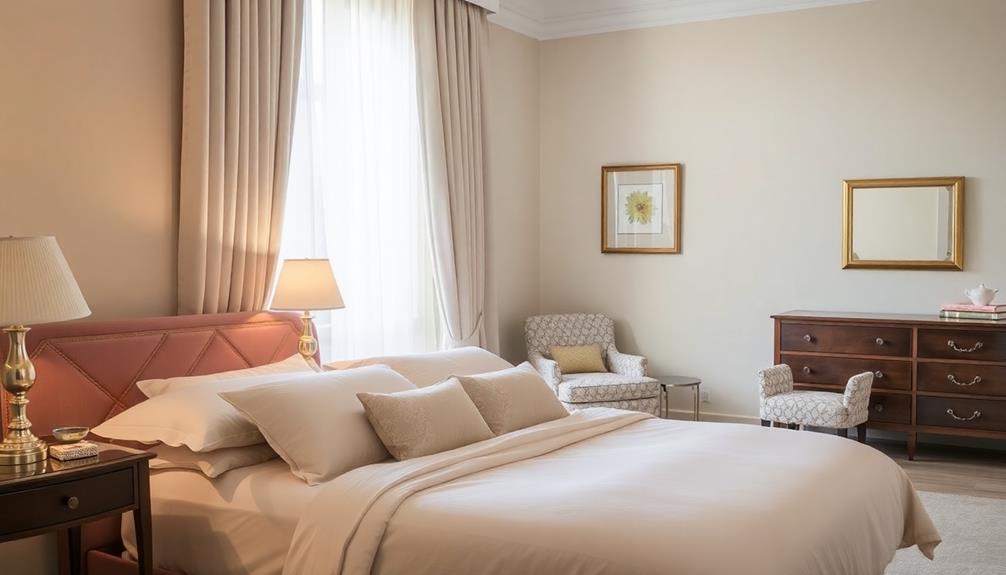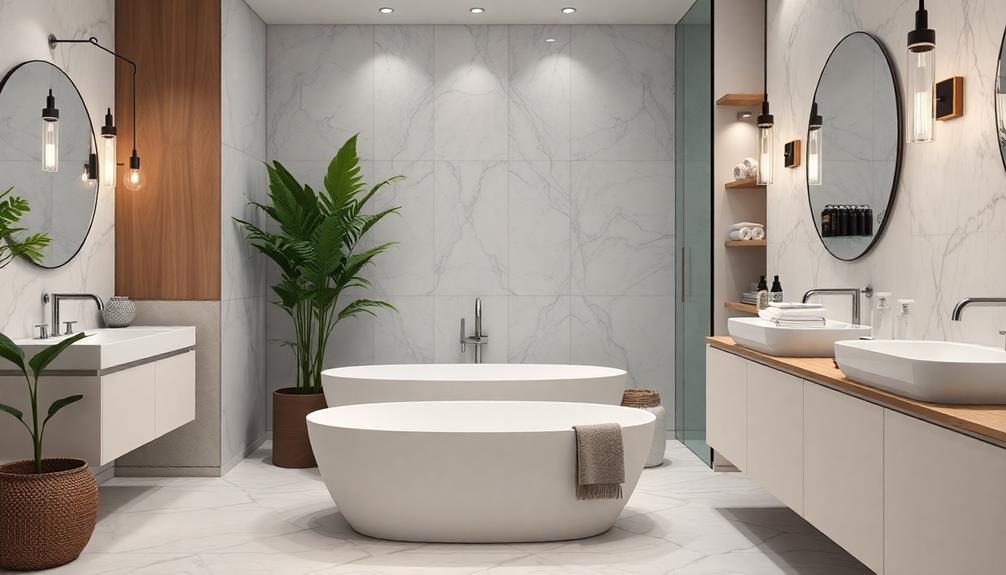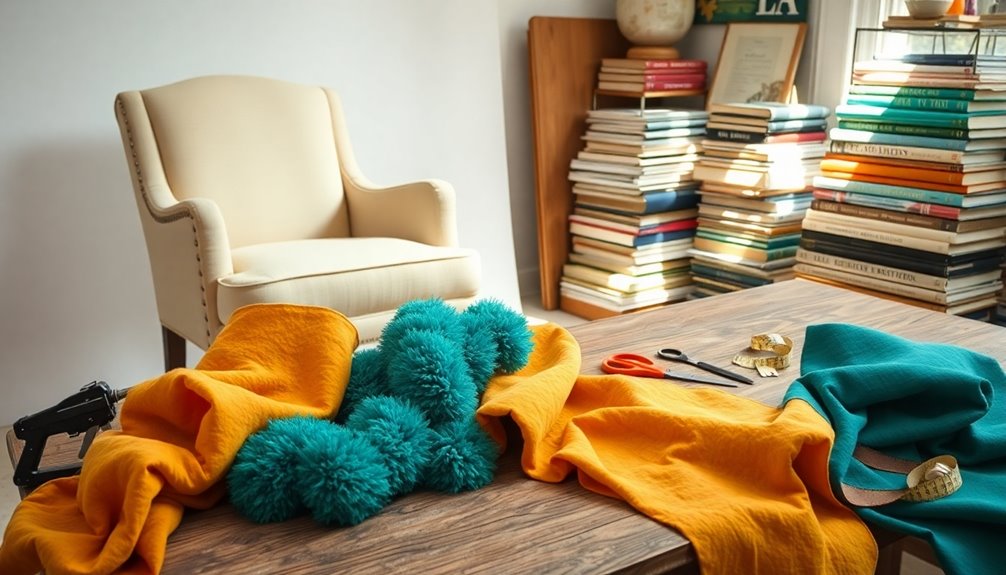In order to effectively organize your bedroom furniture, start by measuring your space and considering its primary function. Place the bed against the longest wall to create a focal point and make sure there is at least 24 inches of space for bedside tables. Utilize a variety of furniture sizes and ensure clear pathways for easy movement. Establish functional areas such as a reading nook or workspace while maximizing natural light. Remember to incorporate storage solutions like under-bed boxes and multi-functional furniture. By carefully arranging your furniture and adding personal touches, your bedroom can feel cozy and uniquely yours. Explore further for additional tips on optimizing your space.
Key Takeaways
- Measure room dimensions and assess functionality to determine the best furniture arrangement for your needs and maximize space.
- Position the bed against the longest wall for a focal point and leave 24 inches for bedside tables to ensure accessibility.
- Create defined functional areas, such as a reading nook or workspace, to enhance organization and comfort within the room.
- Optimize storage with under-bed boxes, multi-functional furniture, and vertical shelves to reduce clutter and maximize floor space.
- Layer lighting and incorporate textiles to enhance ambiance, comfort, and visual appeal throughout the bedroom.
Assess Your Space
When you're ready to arrange your bedroom furniture, the first step is to assess your space. Start by measuring the dimensions of your room, including the height and length of the walls. This guarantees your furniture fits appropriately without overcrowding the area.
Think about the primary function of the room—whether it's mainly for sleeping or if you need a workspace. This will guide your furniture selection and arrangement decisions. Additionally, consider incorporating elements like comfortable seating or a cozy reading nook to enhance the functionality of the space, similar to designing the perfect alfresco living space.
Next, consider the needs of everyone who uses the room. If you've got kids, you might need a specific area for play or study. Pay attention to the placement of windows and doors, as maximizing natural light can make the space feel larger and more inviting.
Additionally, maintaining clear pathways is essential for smooth traffic flow around the room.
Before making any purchases, visualize potential furniture arrangements. Use sketches or virtual planning tools to explore different layouts. This can help you avoid miscalculations and guarantee that everything fits nicely, creating a comfortable and functional bedroom.
Taking these steps to assess the space will make arranging bedroom furniture a much easier task.
Bed Placement Tips
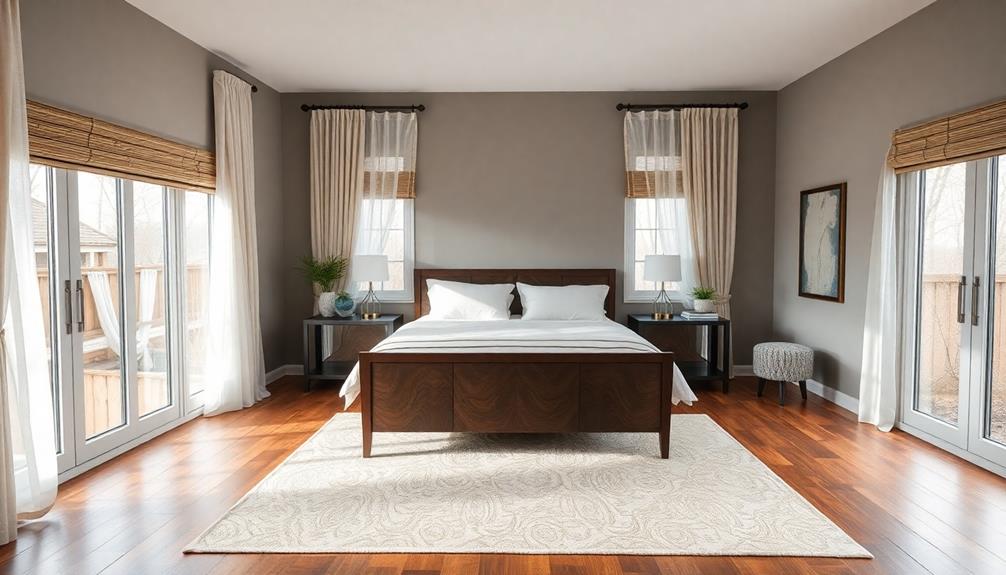
Once you've assessed your space, the next step is to focus on bed placement. Your bed should serve as the focal point of your bedroom, so choose its location wisely.
Consider incorporating elements from Modern Farmhouse Decor Trends (2024) to enhance the aesthetic surrounding your bed. Here are some bed placement tips to help you arrange furniture effectively, even in small spaces:
- Position against the longest wall: This maximizes floor space and enhances the room's aesthetics.
- Avoid walls with doors or closets: This improves flow and creates a balanced layout, enhancing comfort.
- Leave room for bedside tables: Aim for at least 24 inches of space on both sides for easy access and harmony.
- Ensure a view of the door: Position the bed so you can see the door without being directly in line with it, promoting a sense of security.
- Consider height and visual balance: Select surrounding furniture that complements the bed's height to avoid overcrowding.
Optimize Storage Solutions
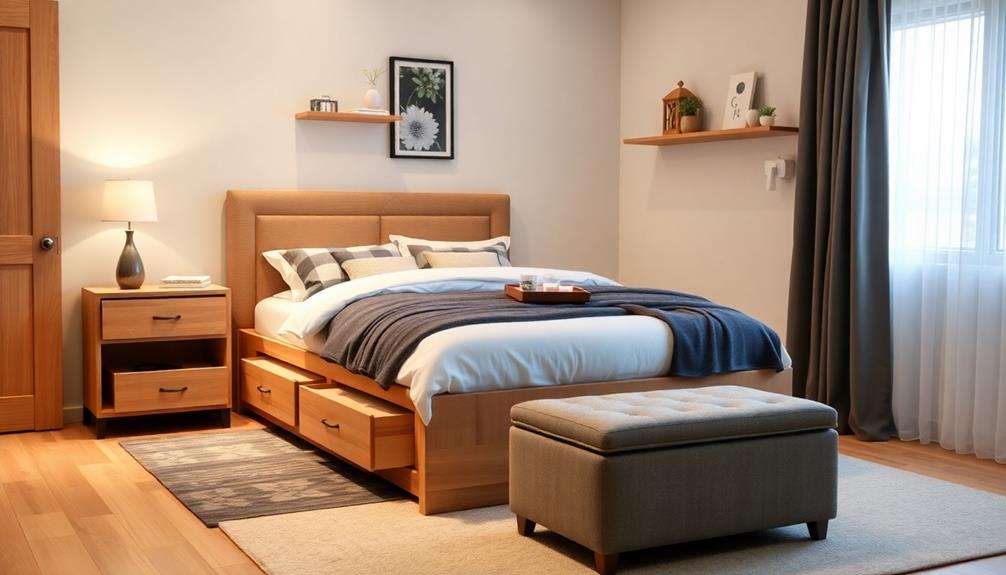
Creating an organized bedroom can greatly enhance your comfort and functionality, and there are plenty of smart storage solutions to explore. To optimize storage solutions, consider incorporating furniture arrangements that maximize your available space. Here are some effective ideas:
| Storage Solution | Benefits |
|---|---|
| Under-bed storage boxes | Keeps seasonal clothing and linens out of sight, maximizing floor space. |
| Nightstands with drawers | Provides essential storage for personal items, reducing clutter. |
| Vertical storage shelves | Utilizes height to free up floor space while showcasing decor. |
| Decorative baskets | Offers quick organization of smaller items, adding style to your room. |
| Multi-functional furniture | Combines additional seating with hidden storage options, like ottomans. |
Define Functional Areas
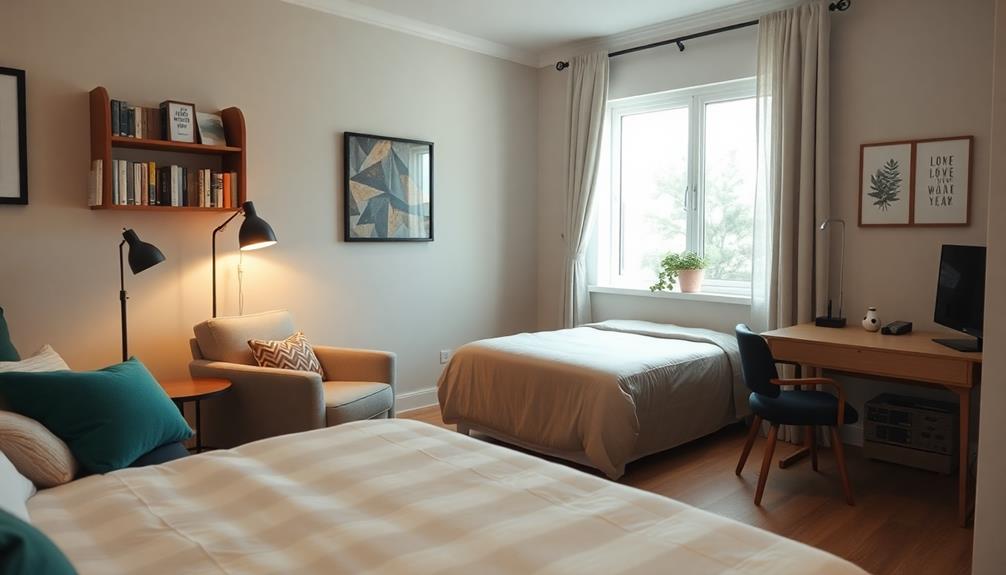
To create functional areas in your bedroom, start by identifying the activities you want to accommodate, like sleeping, working, or relaxing.
Incorporating a well-thought-out layout can enhance the flow of your space, making it more inviting. Consider using multipurpose furniture that can serve more than one function, maximizing space and utility.
Activity Zones Creation
Defining distinct functional areas within your bedroom can transform it into a more organized and usable space. By creating specific activity zones, you'll enhance the overall utility of the room.
Consider incorporating the following functional areas:
- Sleeping Zone: Place your bed centrally, ensuring it's the focal point.
- Reading Nook: Use a comfy chair and a soft rug to create a cozy corner for relaxation.
- Workspace: Position a desk in a well-lit area, complete with a desk lamp for focused tasks.
Effective preparation can maximize your workspace functionality.
- Storage Area: Organize your belongings with strategically placed dressers or shelves.
- Relaxation Zone: Add soft lighting and cushions for a calm retreat.
Use rugs to visually separate these areas and maintain clear pathways for easy movement.
Lighting is essential—ensure each zone has appropriate fixtures to support different activities.
Finally, keep a consistent color palette across all functional areas to create harmony and enhance the room's aesthetic.
With thoughtful furniture arrangements and dedicated activity zones, your bedroom will feel more inviting and efficient.
Multipurpose Furniture Usage
Multipurpose furniture can be a game-changer in maximizing your bedroom's functionality. By selecting the right pieces, you can easily define distinct functional areas within your space, such as a sleeping zone, a workspace, and a relaxation nook. For instance, a daybed serves dual purposes as both a bed and a seating area, effectively maximizing space efficiency.
Incorporate a petite desk or a foldable table to create your dedicated workspace without overwhelming the room. This setup allows you to focus on tasks while maintaining a clean and organized environment.
Additionally, consider storage ottomans or benches at the foot of your bed; these not only provide convenient seating but also offer hidden storage for blankets or books, keeping your space tidy and clutter-free.
To visually separate these functional areas, placing rugs strategically can help define each zone. By using multipurpose furniture and thoughtful organization, you can transform your bedroom into a versatile sanctuary that meets all your needs.
Embrace these tips, and enjoy a well-arranged space that enhances your daily activities and relaxation.
Lighting and Ambiance
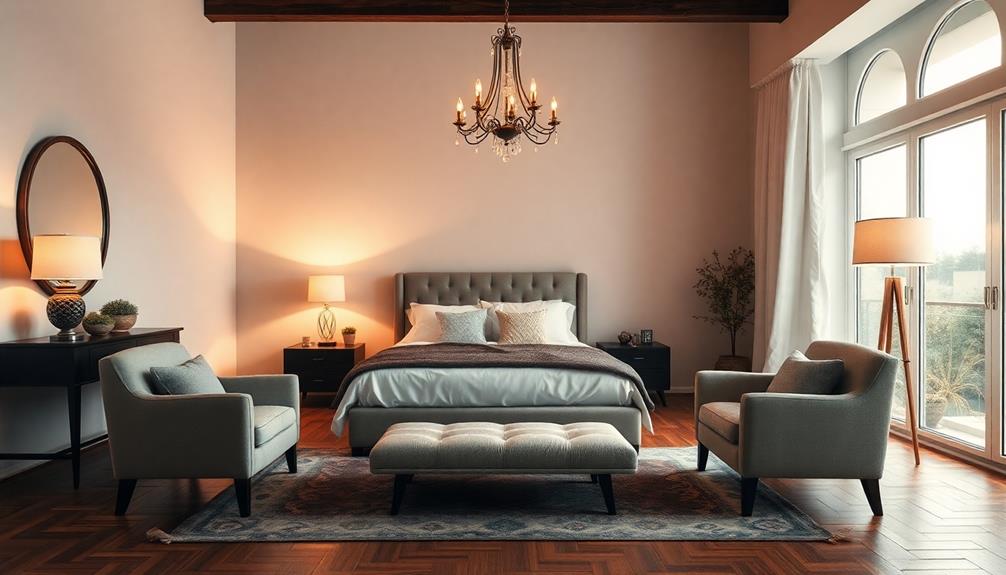
To create the perfect lighting and ambiance in your bedroom, you'll want to layer different types of lighting for maximum effect.
Incorporating natural light with sheer curtains and thoughtful decor can brighten your space and set the right mood.
Don't forget to reflect on how textiles can enhance the overall atmosphere, making your room feel both inviting and stylish.
Layered Lighting Techniques
Creating the perfect atmosphere in your bedroom relies heavily on layered lighting techniques, combining different types of illumination to enhance both functionality and style.
By integrating ambient light, task lighting, and decorative fixtures, you can create a cozy, inviting space.
Here are some key elements to contemplate:
- Ambient Light: Use ceiling lights or dimmers to adjust the overall brightness, setting the mood for relaxation.
- Task Lighting: Bedside lamps are ideal for reading or other focused activities, ensuring you have the light needed without straining your eyes.
- Decorative Fixtures: Incorporate chandeliers or pendant lights to add a stylish touch while providing essential ambient light.
- Cozy Corners: Strategically placed floor lamps or wall sconces can create inviting reading nooks, adding depth and warmth to the ambiance.
- Layering Techniques: Combine different light sources at varying heights to create a well-rounded atmosphere that feels both functional and aesthetically pleasing.
Natural Light Maximization
Maximizing natural light in your bedroom not only enhances the overall ambiance but also improves your mood and energy levels. Start by positioning your bed near windows to take full advantage of natural light, creating a cheerful atmosphere. Use sheer or light-filtering curtains to allow sunlight to stream in while maintaining privacy.
Consider your bedroom layout carefully; avoid placing furniture that blocks windows to guarantee light flows freely. Incorporate light-colored walls and furnishings, as they reflect sunlight better than darker tones. Reflective surfaces, like mirrors or glossy furniture, can be strategically arranged to bounce light around the room, making it feel larger and more open.
Here's a simple table to visualize your options:
| Action | Result |
|---|---|
| Position bed near windows | Enhances brightness |
| Use sheer curtains | Allows natural light in |
| Add mirrors | Bounces light, expands space |
| Choose light colors | Amplifies natural light |
| Avoid blocking windows | Guarantees light flows freely |
Ambiance Through Textiles
A well-arranged selection of textiles can transform your bedroom into a cozy sanctuary. By thoughtfully layering textiles, you can introduce comfort, texture, and visual interest, enhancing the overall ambiance of your space.
Here are some ways to elevate your bedroom's atmosphere:
- Layer throws and decorative pillows: These add comfort and a splash of color, making your bed more inviting.
- Utilize soft lighting: Bedside lamps and fairy lights create a warm glow, perfect for winding down.
- Incorporate area rugs: They define spaces within your bedroom, adding warmth and style underfoot.
- Choose high-quality window treatments: Blackout curtains or sheer shades provide privacy and light control while complementing your decor.
- Add scented elements: Candles or diffusers with soothing fragrances enhance the sensory experience, promoting relaxation.
Furniture Arrangement Techniques
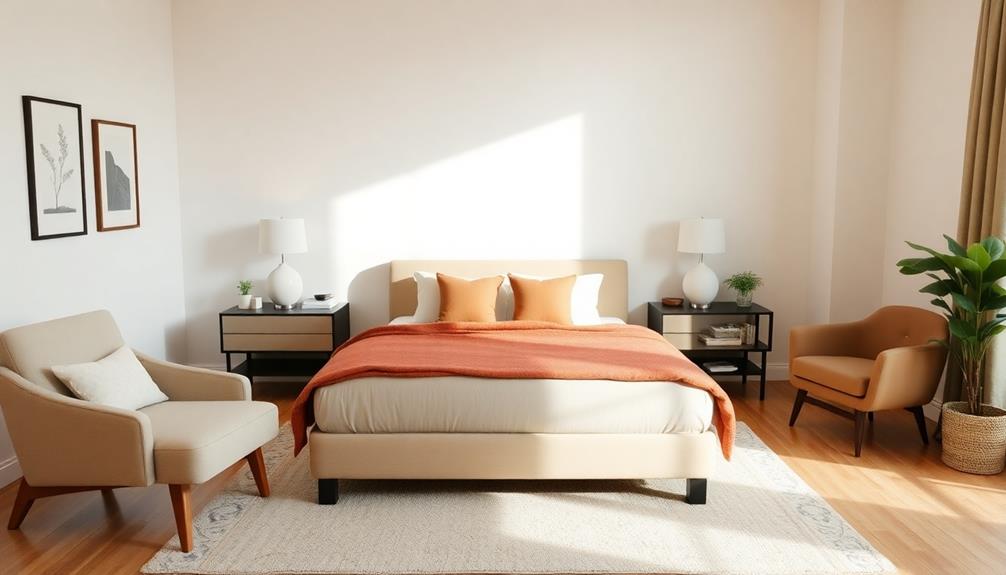
Arranging bedroom furniture can dramatically change the feel and functionality of your space. Start by placing the bed against the longest wall; this not only frees up floor space but also creates a striking focal point. Position the bed away from the door and closet to maintain a balanced flow and easy access throughout the room.
Incorporate a mix of furniture sizes to avoid overcrowding and enhance visual appeal. It's important to keep clear pathways around the space to promote comfort and accessibility. Utilizing rugs can help define different functional areas within your bedroom; make sure the rug is placed under at least the lower two-thirds of the bed for that cozy touch.
Experimenting with various furniture arrangements during your first few weeks in the space will help you discover what layout best suits your needs.
| Design Tips | Effective Arrangements | Emotional Impact |
|---|---|---|
| Bed against longest wall | Clear pathways | Enhanced comfort |
| Mix large and small pieces | Define functional areas | Visual harmony |
| Rug under bed | Easy access | Inviting atmosphere |
| Away from door | Balanced flow | Peaceful retreat |
| Experiment | Personal connection | Joyful living space |
Personalization and Decor
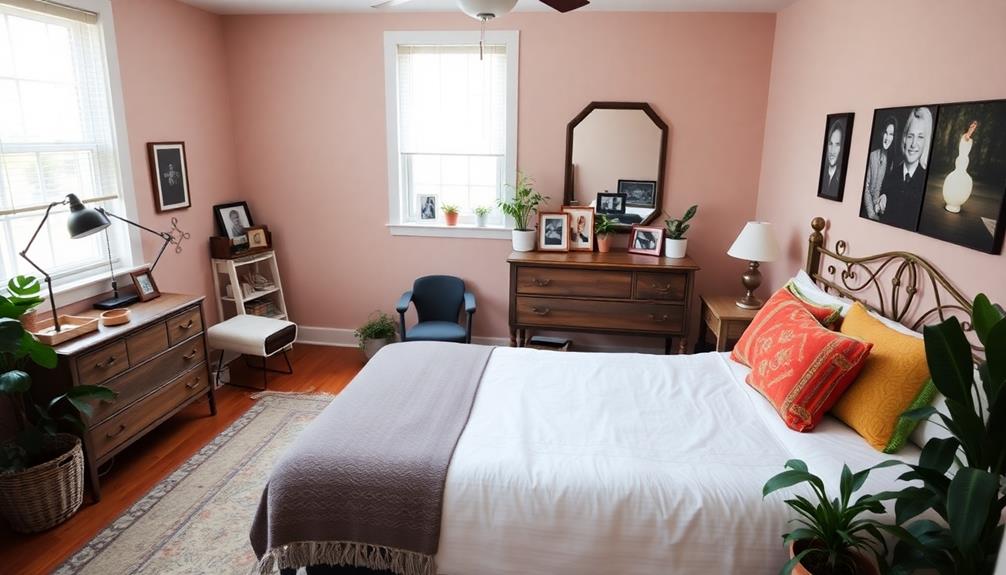
Personalizing your bedroom transforms it into a sanctuary that truly reflects who you are.
When you focus on personalization and decor, you create an inviting space that resonates with your interests and style. Here are some tips to get you started:
- Choose meaningful items: Incorporate heirlooms or decor that tells your story, adding a unique touch to your interior design.
- Use color and patterns: Select hues and patterns that express your individuality, ensuring they harmonize with the overall design without overwhelming the room.
- Create a gallery wall: Showcase art or photographs that resonate with you, adding character and a personal touch.
- Incorporate decorative textiles: Use throws and pillows in various textures and colors to enhance comfort and visual interest.
- Balance personal and functional decor: Keep your space serene and organized while showcasing your personality.
Seasonal Adjustments
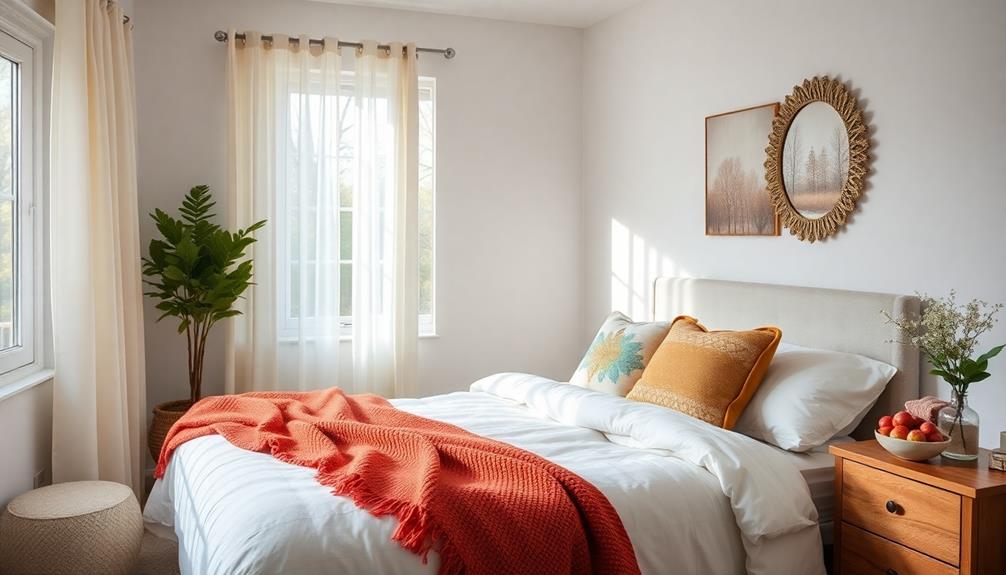
Embracing seasonal adjustments in your bedroom not only keeps the space feeling fresh but also enhances your comfort throughout the year.
To start, rotate your bedding, pillows, and accessories with the seasons. For warmer months, choose lightweight fabrics and bright colors to create a fresh atmosphere. In contrast, during colder months, incorporate heavier textiles and warm hues to foster coziness.
Regularly assess your furniture arrangements to accommodate seasonal changes. For instance, create space for summer hobbies by arranging furniture in a way that promotes activity.
Alternatively, set up a cozy reading nook for winter, allowing you to curl up comfortably with a good book.
Don't forget to incorporate seasonal scents, like candles or essential oil diffusers, to enhance your bedroom's ambiance. This small touch can make a significant difference in how welcoming your space feels.
Multi-Functional Furniture Options
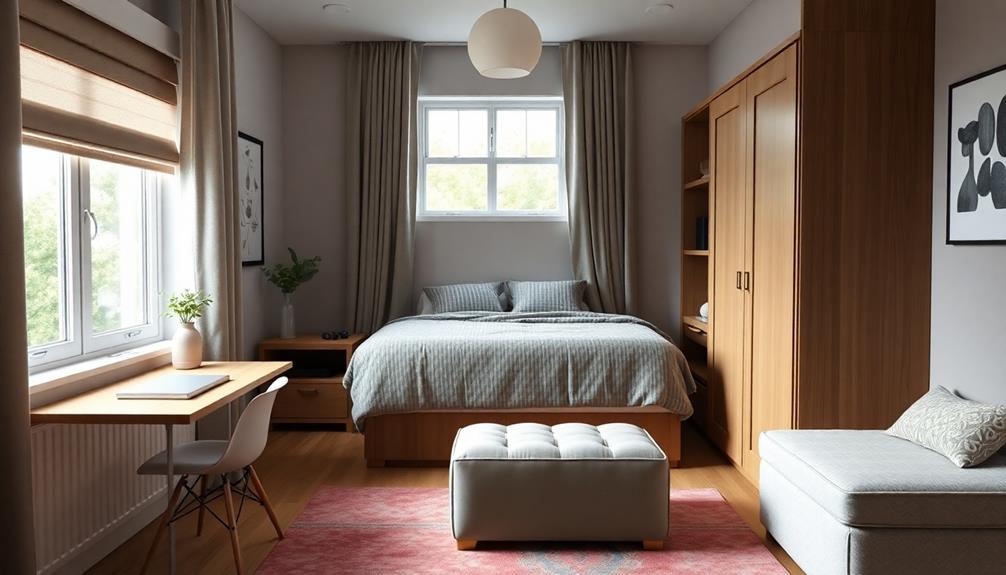
Seasonal adjustments can create a dynamic environment in your bedroom, but maximizing space and functionality is just as important.
One way to achieve this is by incorporating multi-functional furniture options. This approach not only enhances the room's utility but also helps you keep everything organized, especially if you're working with a small bedroom. For example, choosing a bed frame with built-in storage or a foldable desk can maximize the available space without sacrificing style or practicality. Additionally, you can separate a sectional sofa into individual pieces to create distinct zones for lounging or socializing, further enhancing the room’s versatility. These strategies allow you to optimize every inch of your bedroom while maintaining a cohesive and functional design.
Here are some great ideas to contemplate while arranging your furniture:
- Foldable Desk: Easily store it away when not in use for extra space during the day.
- Storage Ottoman: Use it at the foot of your bed for seating and to stash away extra blankets.
- Bed Frame with Drawers: This clever design lets you utilize under-bed storage for seasonal clothing.
- Multi-Function Nightstand: Look for one with a charging station and shelving for books or decor.
- Murphy Bed: Fold it up when not in use to transform your room into a versatile workspace.
Frequently Asked Questions
How Do You Decide Where to Put Furniture in a Bedroom?
To decide where to put furniture in a bedroom, start by measuring the space. Assess its primary function, then experiment with layouts to guarantee flow, balance, and accessibility while maintaining a cohesive style.
Where Should a Dresser Be Placed in a Bedroom?
When envisioning your sanctuary, think of your dresser as a centerpiece. Place it opposite your bed for balance, ensuring it's within easy reach of your closet, while avoiding blocking natural light or pathways.
What Is the Correct Way to Set up a Bedroom?
To set up your bedroom correctly, start by positioning your bed against the longest wall. Make certain you've got access on both sides, create clear pathways, and use rugs for comfort and visual appeal. Experiment until it feels right.
How Much Furniture Should You Have in a Bedroom?
How much furniture do you really need in your bedroom? You should stick to three or four essential pieces to keep it spacious and functional. Remember, less often creates a more serene and inviting atmosphere!
Conclusion
Arranging your bedroom furniture might seem overwhelming, but it's all about creating a space that feels right for you. Don't worry if you think you lack design skills; trust your instincts and experiment. Remember, it's not about perfection but comfort and functionality. As you personalize your space, you'll find that it reflects your unique style and needs. Embrace the process, and enjoy the transformation of your bedroom into a haven that truly feels like home.
